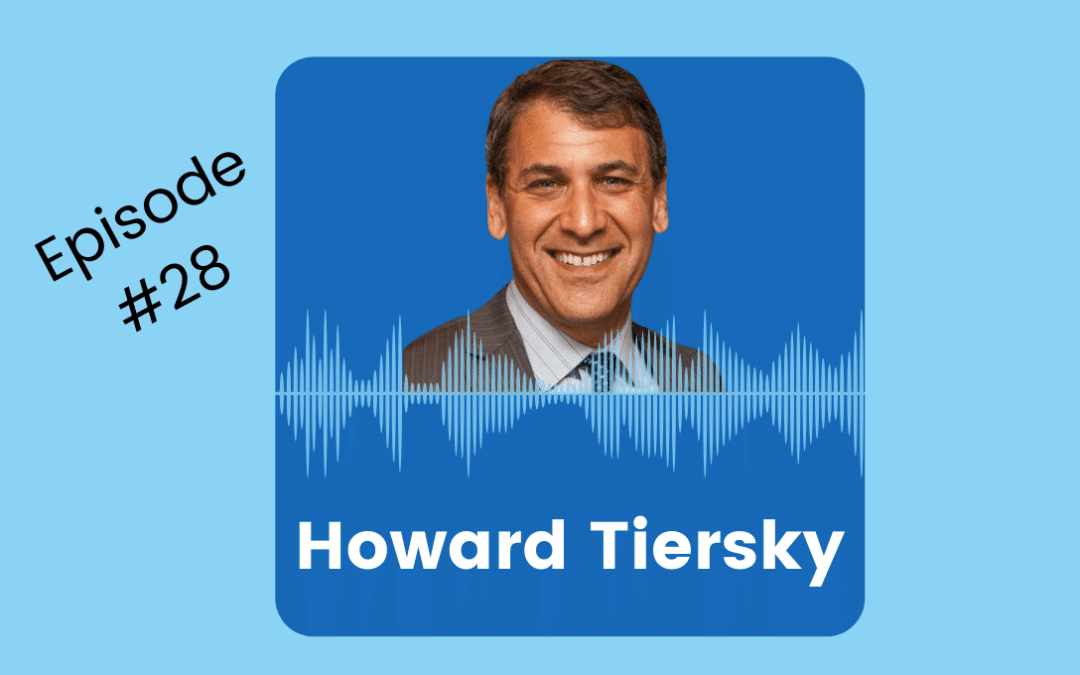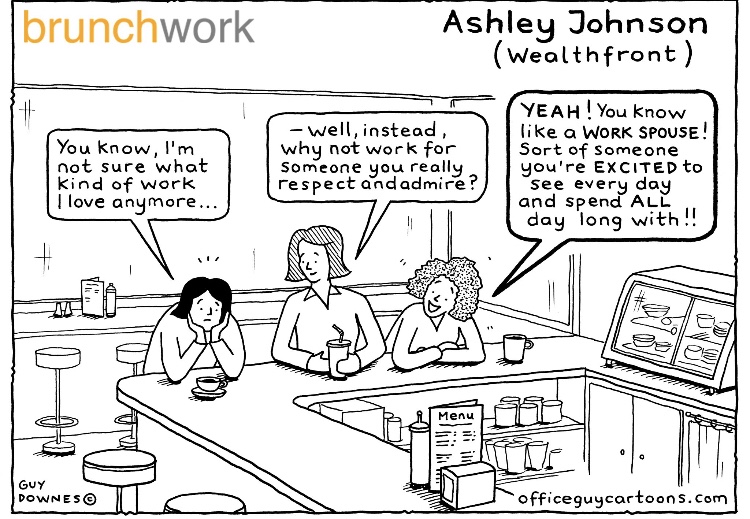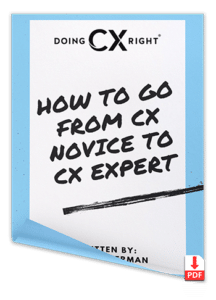
Doing What’s Right For Customers While Balancing Internal Processes
“Your employees’ behavior is your customer experience. You can’t separate them out, as Bill Staikos, Senior VP at Medalia, explains during an interview with Stacy Sherman about doing what’s right for customers.
So, how do you lead with excellence? What is the ideal organizational design to best care for your customers? Is the Chief Experience Officer (CXO) role a fad or growing in importance? What’s the right way to design new products based on what customers really want while balancing internal processes? You’ll hear answers to these questions and more about differentiating your brand in this podcast episode.
Watch Stacy Sherman’s Interview on Youtube
PODCAST TRANSCRIPT
Doing What’s Right For Customers While Balancing Internal Processes
Stacy Sherman: Hello Bill Staikos. Welcome to the Doing CX Right show.
Bill Staikos: It’s great to be here with you. It’s nice to see you again, it’s been a while.
Stacy Sherman: You too. I know. Well, I had the honor to be on your show. So it’s only fair now that I’m hosting to have you as my guest. So thank you for saying yes.
Bill Staikos: Oh my gosh. It’s my honor. It’s a privilege to be here with you.
Stacy Sherman: So let’s get into the beginning topics. I like to ask people upfront. Because you have done so much with your career, tell the audience, who are you, what do you do professionally?
Show More
Bill Staikos: I am a senior vice president at Medallia, which is the leading customer experience management cloud-based platform.
I lead a global team called Industry Solutions. It is a team that is former leaders and practitioners like you are in your day job, Stacy. And like, I used to be in my former day job, and we help clients be successful over the long-term. But beyond that, been in the customer experience space for over 20 years as well as employee experience.
So it’s been a, it’s a nice change to be on this side of the fence sometimes, and now actually.
Stacy Sherman: I get it. Now you have done so much as I shared about customer experience, customer success, employee experience. What’s your why? Why are you so passionate about it?
Bill Staikos: So it’s actually, it’s, it’s changed over the years.
Over the 20 plus years, I’ve been working in this space. I mean, originally I really wanted to create experiences that people loved. I know as a consumer, I wanted experiences that I loved. So I wanted to be able to, you know, work as part of an organization that did that for their own customers. Or employees for that matter.
We’re now like, you know, after doing this for so long and no one’s told me to stop doing it. So I will continue to do it until someone tells me to stop. It’s more about helping others be successful in their roles. And that’s what I really love about my role at Medallia. I’m helping other customer experience leaders, employee experience leaders be successful in their own, right at their own companies and create value for employees, for customers, for shareholders, and that fills my cup now.
Stacy Sherman: I always say that CX people, CX professionals are the nicest people you’ll ever meet. And so when you talk about your role and your why, I really believe it. Everybody I meet in this frame of work is truly passion, heartfelt people. Do you find that same?
Bill Staikos: So I do, I was just speaking with someone this morning at an original bank actually, and she’s new to customer experience.
She comes out of the business and she said, you know, it’s really fascinating to me. It’s not something that I’m used to, everyone that I talked to in customer experience is really helpful. They give me content, they give me ideas. They tell me how they’re doing it. They want to trade ideas. They want to set up regular calls.
I think that this community is just from a professional perspective is one of the most helpful and altruistic out there, and I think that is just something that’s in our nature, and we want other people in the same discipline to be successful just inherently.
Stacy Sherman: I agree. So there’s a lot of people like McDonalds, Walmart and other brands that are hiring CXOs.
And the question is there’s so much discussion in the news. Do you see this as the long-term investment that companies are making, or is this just a fad of having CXOs in companies? What’s your view?
Bill Staikos: So I personally don’t think it’s fad. I think right now, just given the importance of customer experience and not just from the customer’s perspective, but the employee experience as well, companies are starting to realize that employee experience and customer experience are not two disciplines.
In fact, we shouldn’t even be talking about them differently or separately. You use the same toolkit. You’re talking about the same things in some level, it’s all a human centered design toolkit for both sides. So, a customer experience officer or excuse me, a chief experience officer, as, you know, some of the articles that you’re referencing and how like McDonald’s and other very, very large brands are, are bringing into their C-suite.
Those individuals are coming across because they believe, and they understand. And I didn’t say this, but I’m going to quote someone on my team …your employees behavior is your customer experience and you can’t separate those two things out, you can’t go fix the digital experience where the contact center experience and technology that customers use to maybe engage the context center without then working on the employee experience side and making employees better and elevating them too. If you don’t the experiences are disjointed and you’ve just wasted a lot of money in one side of the one side of that same coin.
Stacy Sherman: Very well said. Now organizations are often trying to figure out what is the right setup, where should CX sit in the company? What’s your opinion based on being at where you are now on a provider of the services, and then you were also a Freddie Mac and other places in your career, what have you seen work? Well?
Bill Staikos: So it really depends company by company. At Freddie Mac, I reported into the COO, there was a real need from an operational perspective to think about the customer experience and how that was being delivered through product owners as an example. So we work closely with product owners as well as the broader business. At Chase, I reported to the CAO, Chief Admin Officer.
I think now, as companies start to evolve their thinking around experience and what that means and how that can have direct impact to their overall business strategy, I think that smartly they’re bringing that role into the C-suite, whether it’s a Chief Customer Officer, Chief Experience, Officer, Chief Customer Experience Officer, right?
The flavor kind of depends on the company, but I think that that sits in the C-suite and helps other parts of the organization, think about their end consumer in ways that they can be operationally better, more efficient, plug revenue leaks, drive more revenue, create experiences that help companies drive the strategy that they have out there in place versus, hey we want to increase our satisfaction five points or whatever that is, which I don’t think ever should be necessarily the goal.
I think that the toolkit should be used in a way, you know, if a bank wants to increase revenues by 10%, go figure out the great experiences that drive your revenues 10% higher. Don’t say we need to increase the loyalty. That doesn’t make sense. Right? What’s the sort of the business driver behind that.
And how do you increase loyalty that helps achieve that business goal?
Stacy Sherman: Marketing. I’ve been in marketing and sales. I fell into CX, ironically. My question is where does marketing play in your perspective, the CMO, the CXO does marketing report into experience? Does the customer experience report into marketing?
Is there a blend? Lots of different views on this? What is yours?
Bill Staikos: So I think that when you look at companies like Walmart, when you looked at companies like McDonald’s now, marketing is reporting into the CXO. And I think that’s a really interesting trend, right? At the end of the day, marketing, and look, I’m not a marketer, so this may be overly simplified and I’m sure I’ll get some hate mail from marketers perhaps for saying this, but, you know, marketers are there to help define that promise to the end consumer.
What does that, you know, what is that? What do we stand for as a company and what should you expect from us? The experience team should be able to connect that promise with what is actually happening at the ground level, in store, online on an app, et cetera. So consumerism left, like, gosh, I thought that they stood for something completely different,
and now I’ve got this bad experience in that experience. It really doesn’t make sense to me. I don’t want to deal with this organization anymore. I’m going to go somewhere else. So, I don’t know if CX should report into the CMO or CMO should report into CX. I think that is a very business specific decision based on where a company is and their evolution maturity.
But I do know that, the Chief Marketing Officer and the Head of Customer Experience or CXO, they need to be lockstep. As much as the CXO needs to be lockstep with the CFO. So if they’re not partnering well, it will create a lot of friction, and frankly, the it’s not just sort of, you know, the consumer and the employee will lose out in the long run.
And that’s not fair to them, and that clearly will have an impact on your overall business and their performance.
Stacy Sherman: I’m glad you brought the CFO topic as well, because I go around my workplace and I continue to tell everyone they have a CX job. And they’re like, well, no, cause I’m back office.
No I don’t, and I said, oh yes, you do. Let me tell you why. And finances is part of it. Huge part of it because obviously you can’t pay your bill. That’s a huge pain point. Does it matter that the buying experience was delightful? Without every moment of truth, it’s a problem. And so that’s part of what you do and Medallia, and we’re not promoting any brand here.
We’re just talking about in general that the importance of platforms can help companies really be able to measure the customer sentiments and feelings and likelihood to recommend and all of that through the journey. Agree? And anything to add to that?
Bill Staikos: So I think it’s really, so, you know, the really important point there is, having a journey mindset.
And moving away from a product mindset to a journey mindset, and not just, you know, your customer data, you know, through a survey or something else. But, you know, as you alluded getting behavioral data, operational data, financial data sentiment, all really baked into the way that the analysis that you’re doing, the questions that you’re asking through the journey to be able to identify real business metrics that are being impacted by the experiences that are being delivered.
I’ve always said to the two most important people in any CX leaders relationship and like within the first five minutes of starting in a company, go get coffee with these individuals as the CFO and the CHRO. Because ultimately you need to understand what’s happening at the employee level. You will bring that customer perspective and you need to understand like what business metrics matter at this company, how do we make money?
Right. What measures do we care about? What goals do we have around those measures? You need to absolutely be tying your work to those financial metrics and absolutely be tying your work to those employee metrics.
Stacy Sherman: I agree. I had some jobs where I was the only one with those metrics tied to my objectives and it made my job hard because when I would bring, I was managing an e-commerce channel and when customers couldn’t add to cart. They couldn’t check out. I would bring that to the different website department owners who could fix that. And they had different goals than I did. So it wasn’t urgent to them. And that’s why you need everybody’s buy-in and you need everybody measured in the same way. And I find that’s also a problem.
When you talk about omni-channel before. If your online department has a set of goals and your retail store offline has a different set of goals. The customer gets lost. It’s frustrating.
Bill Staikos: Yeah. Part of that though, is the word channel in and of itself is a very inside out word. Right? For listeners. I’m holding up my phone.
I’ve never called my phone a channel. But if I’m a bank or if I’m a retailer, you would call this my digital channel, right? Maybe the website could be your digital channel too. Nobody calls us a channel. No consumer in the right mind would call this a channel. I also don’t think in terms of, I’m going to go to the app.
I have a question. I may go to the website. I still have questions. I’m going to call the contact center. I don’t think of those three things as channels. I think of them as. Opportunities for me to get, actually get what I need done as quickly as possible. And those are the, just the platforms that companies have developed for me to go execute that transaction, whatever it might be.
So, I think we need to stop talking and thinking about channels and think about it from the consumer outside in. And that’s why that, that consistency that you’re I think, referring to. So, my in-app experience is great, but I call the contact center and it completely fails me not to pick on context center folks.
They’re all wonderful, but that disconnect is a real problem. And I don’t think that I don’t think that organizations pay enough attention to that. And it’s largely because we think in channels and we’re organizationally structured with channels too.
Stacy Sherman: I love that example. I want to add one. I’m going to add one, not from the CX hat I wear, but from as a consumer, I bought a product online.
A shirt for my daughter. It didn’t fit. And I decided I was going to the local store and decided, let me bring that shirt with me. And they said, sorry, we won’t take it back. We can’t take it. You bought it online. And I said, put your the same company. You’re telling me I have to leave. Can’t get my money back.
Can’t give you the product. I had to take a home and now mail it to you with a shipping cost. Ouch.
Bill Staikos: Yeah. And if you bought it online, you can probably ship it to that store and go pick it up there, but they won’t return a product there.
Stacy Sherman: Right. So that’s where I say that you’re right. We can’t talk in channels.
It’s experiences. It’s one company to the customer, even though the company siloed, but to the customer, nothing could be more aggravating. I won’t shop there again because of that one story. So going back to what we were talking about, organizational design, how do you get that not to happen when you have your digital team and your call it offline retail team.
What’s that structure? How do you resolve that?
Bill Staikos: So that’s where I think organizing around journeys is really important. And not a lot of companies do that today. Some do. I think as we start to see more of a shift from product or channel mindsets to more journey based mindsets, I think that you will see organizations move away from that type of structure more and more, and you will have journey owners and organizations, and you will have individuals that own multiple journeys, you know, it won’t just be the onboarding journey and have one owner, right.
It’ll be a couple of, kind of threaded together. And I think the organizations that are already starting to think that way are the ones that you buy from today that, that you love buying from every day. And I think we’re going to see more and more of that. We’re still sort of in the early adopter phase, so to speak of that movement.
But I think you’re going to see that over the next three or so years maybe five, be a very new way of thinking that folks will start to adopt more.
Stacy Sherman: I also think that we see X professionals have the chance to be the glue in the organizations. So while all these different teams are. I hate saying silos.
Cause that sounds so negative, but it is reality in big, big companies. So we get to be the glue. So when there’s let’s say a customer journey or experience where there’s one product line or business line, let’s say there I’m in construction. One example is in the construction field. After something’s built.
Now, we want to turn it over to the service side and be able to do maintenance and repair. And so the customer experience team gets to really look at that seamless connection because they’re two different departments. They’re even two different buyers and influencers. And so I encourage CX professionals and partners and platform providers to really help be the glue, be the connector, because like we said, the customer is the only, it’s one company to the customer.
Bill Staikos: I think that’s why you see a lot of platforms and technology players, the CX tech stack, so to speak, really thinking about. How do you bring disparate sources of information and data together to be able to analyze it in one place? I mean, we do that at our, you know, certainly we deliver that capability where I am, and I think that’s just a really important part of the work.
Now I will say that I don’t know if it’s necessarily for the CX team to manage and own. I think where it’s going more and more is being able to democratize the platform, in the organization. So folks in the back office folks on the front line, they have ready access to all of those insights so they can make those real time important decisions around the customer that can also influence and create that great experience versus a centralized team kind of managing that and distributing it out, you know, on some regular cadence.
Stacy Sherman: Well, either way, I think it all goes back to, you need a customer experience champion at the top, you need a champion aligned and aligned with marketing and finance and HR and IT, there has to be that close alignment. Customer experience has to be at the table. Marketing has absolutely a big part of it. There’s some blending there and you need the bottom up as well.
Bill Staikos: Sure. A hundred percent, it will not work without employees on the ground level that are dealing with customers all the time, not bought into it. So.
Stacy Sherman: So, I talk about Doing CX Right on purpose because. There’s a lot of companies doing it. Right. There’s a lot we can learn from who would you say is doing it right, and why? What’s an example besides where you work, cause we’re not going to favor where you are or I am so pick a brand.
Bill Staikos: No, I wouldn’t use them as an example, yeah. So look, I think like Chick-fil-A is doing it right. What a great organization that cares deeply about their customers. They pivoted really quickly during the pandemic to have individuals like multiple people down the car line, taking your order.
So when you drove up, it’s immediately ready there for you. The timing is impeccable. They deliver food to you. Can track where your food is. They have mission and purpose, and they intentionally build experiences into the mission and purpose, right? Close on Sundays because they’re religious company, religious owners, they don’t want, you know, it’s God’s day.
They don’t want to be people do or their employees to be working, let alone themselves. So they’re closed on Sundays. I think that that is an organization that a lot of different verticals can look at as an opportunity as a, to draw parallels from in their own business. The food’s not healthy for you necessarily.
But I think the way that they engage you as a customer in the store or the way that they engage you outside of the store, or the way that they engage you in the app, they really do try hard to meet you where you are and then where they meet you, that experience is always consistently good, no matter what the channel is.
I said, I see, I use channel too. I’m guilty.
Stacy Sherman: Yes, you did. I was going to just say that. But what you’re saying is really important because the examples you gave are really about how they’re using technology to enhance the customer experience, but not replace the human factors.
Bill Staikos: Correct. I mean, technology is not the answer. It’s the question. That’s how I think about tech. Right? It’s there to support the human experience in some way, shape or form. So, even if it’s a chat bot or an avatar at the end of the day, you’re trying to create a human experience and connection with your customer. If it was purely digital, there’s not really a company there.
Stacy Sherman: Yeah. We could go into digital experiences as a whole nother hour, but we will pause on that. Let me ask you my final two questions. One is if I had, I like to ask this of everyone, if I had many CEOs, CXOs, CMOs, CFOs, and other leaders in my room right now, what’s the one takeaway, what’s the one thing you want them to know?
Bill Staikos: I would say, do what’s right. Not, don’t be right. And what I mean by that, Stacy is, there are a lot of policies and procedures in place for employees and for customers. But sometimes that policy and procedure doesn’t necessarily mean it allows you to do what’s right by either one of those constituents in your organization.
And I think a lot of companies and certainly how regulated companies they’ve built these processes that are really tight, never any downtime, so much just thought and very, a lot of detail in these processes, it limits your ability to do what’s right. And I know that’s a tough balance and a tough challenge.
So, you know, I got that advice from a CEO actually from Chase. Who’s no longer there, but he’s at a different bank now. He once said, he’s like, don’t be right. Do what’s right. And what he meant by that is just don’t follow the policy. Like what’s the right thing to do here for the customer or for the employee.
Forget the policy who cares. Do what’s right.
Stacy Sherman: Oh, that’s powerful. I also have heard that similarly when it even comes to relationships and friends or family, and there’s some people that have to be right and I say, well, how important is this topic? And do you want to be right? Or do you want a relationship?
Bill Staikos: That’s right. I mean, that’s exactly a hundred percent. Yeah, totally.
Stacy Sherman: So it’s a good, it’s a good, a good advice. Speaking of advice. My last question to you before we close is if you could go back to your younger self Bill and you can talk to 20 year old Bill, what do you know now that you would have told little Bill?
Bill Staikos: You know, I was always a smart kid, I just never applied myself very much. And I grew into that thankfully. So I would tell my younger version, you got to lean in now. Like don’t wait to lean in. And you don’t have to figure it all out, but find your lane and just start running and don’t wait, just get in there.
And you know, I probably got into my groove a little later in life than others may have, but I’d probably tell my younger self that.
Stacy Sherman: I bet a lot of people will appreciate that and you’ll affect somebody’s life listening to this cause it’s great advice. So now is the final bragging moment for you?
Where can people find you your podcast Be Customer Led? I encourage all my listeners to tune in. It’s such good content, but go ahead, Bill. Where can people find you?
Bill Staikos: So I’m on LinkedIn pretty actively. And you know, if folks want to connect and just talk about CX Re-ex, you know, by all means, send me an invite and let’s chat.
You know, becustomerled.com is where I’ve a blog and also the podcast. The podcast has been sort of a labor of love. I’m sure that you’d see that with your own podcast too. We’ve actually gotten a lot of success over the last year, which is pretty neat. We got voted best business podcast for 2021, which is a nice accolade.
We have listeners in 80 countries now, which is that’s the one number that frankly I really care about because it means that customer and employee experience is a global conversation and folks are tuning in. So that’s the one that I’m most proud of. I can really, the awards are nice, but I could really care less about that.
It’s the fact that different cultures and different people are tuning in and listening, which is kind of a cool thing.
Stacy Sherman: Very cool. I will put the link in the show notes and you’re right. It is global. I’m finding the same and we are making a difference. So thanks for being you. And thanks for being here, Bill.
I appreciate you.
Bill Staikos: It’s great to see you, Stacy. Is wonderful to be on the show. Thanks so much for having me.
Stacy Sherman: Take care. See you soon.
About Bill Staikos ~ Doing What’s Right For Customers:
Senior Vice President, Industry Solutions @ Medallia. Expertise spans +20 years across CX Strategy, CX & Contact Center Teach Stack, Research & Insights, Data & Analytics, Transformation, Journey Analytics & Journey Orchestration, Metaverse, leveraging Artificial Intelligence and Machine Learning to make better decisions around the customer, and Customer-led Culture.
Bill hosts a weekly podcast called Be Customer Led. Check out Stacy Sherman’s featured guest episode HERE.
The show explores CX, EX, and how companies develop leaders and cultures maniacal about the customer. The Be Customer Led community spans listeners across +90 countries, won Best Business Podcast for 2021 at the Quill Podcast Awards, and is Top 150 on Apple in the Management category. Recently became a Startup Mentor at 76forward, helping early-stage startups think about how to scale customer and employee experience to create business value.
More about Bill here.
About Stacy Sherman: Founder of Doing CX Right®
An award-winning certified marketing and customer experience (CX) corporate executive, speaker, author, and podcaster, known for DoingCXRight®. She created a Heart & Science™ framework that accelerates customer loyalty, referrals, and revenue, fueled by engaged employees and customer service representatives. Stacy’s been in the trenches improving experiences as a brand differentiator for 20+ years, working at companies of all sizes and industries, like Liveops, Schindler elevator, Verizon, Martha Steward Craft, AT&T++. Stacy is on a mission to help people DOING, not just TALKING about CX, so real human connections & happiness exist. Continue reading bio >here.









 Source: Ashley Johnson
Source: Ashley Johnson